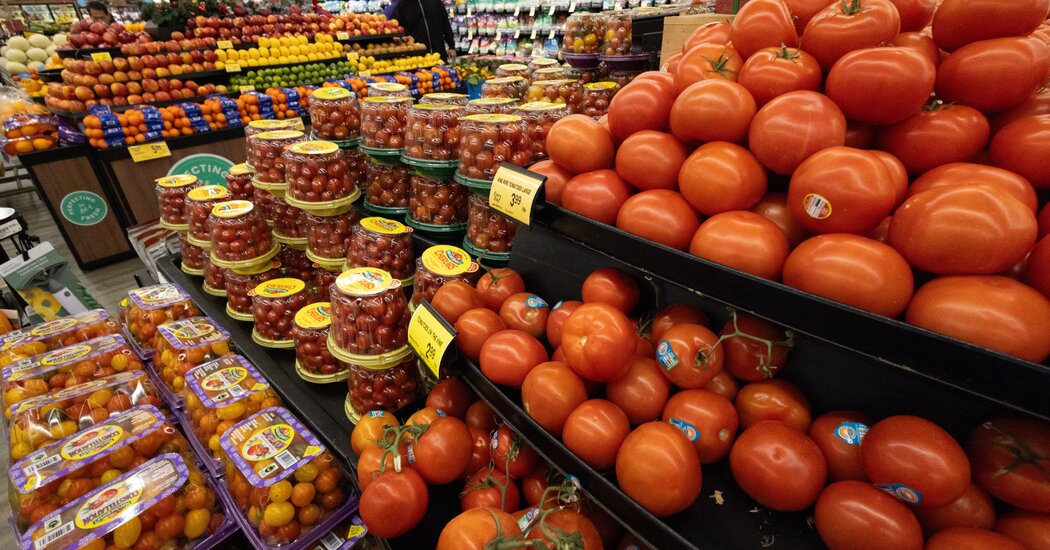Grocery shoppers are likely to feel the impact of the Trump administration’s sweeping new tariffs before April is over. And the first place they’ll feel it is in parts of the store where the inventory has to move fast.
In the produce aisle, food analysts said Thursday, expect small price increases on everyday purchases like bananas from Guatemala and grapes from Peru, countries whose exports to the United States will incur 10 percent tariffs when the new fees go into effect on Saturday. A separate round of reciprocal tariffs on 57 countries will follow on Wednesday.
The seafood counter may hold even worse surprises. Grocery stores sell a lot of shrimp from Vietnam, which President Trump hit with a 46 percent reciprocal tariff, and India, with a 26 reciprocal percent tariff.
Soon, analysts say, price hikes will arrive for staples like sugar and coffee, which is already priced at a historic high. Specialty coffee beans might eventually cost consumers 10 percent to 35 percent more than before the tariffs, bean buyers predicted.
Since the pandemic, grocery stores have been expanding their lines of lower-priced private-label products. Customers loved them as a way to navigate inflation, but tariffs will drive up costs.
“It was a bit of a refuge for consumers,” said Keith Daniels, a managing partner at the investment bank Carl Marks Advisors, who focuses on the food and grocery sectors. “Now that’s not going to be there.”
Still, he and some food executives said that because so much food on shelves in the United States is processed overseas or contains ingredients and packaging from several countries, predicting how tariffs will change food prices is difficult if not impossible.
Some of the cost of the tariffs is likely to be absorbed and not passed on to consumers, as retailers re-evaluate pricing strategies and determine how long the inventory they already have in the country might last.
Still, the opportunity for price gouging or other forms of manipulation are high, said Errol Schweizer, a veteran of the grocery industry who publishes The Checkout Grocery Update, a newsletter.
“Consumers won’t know if things are priced correctly or they are getting ripped off,” he said.
At all levels of the food business, just figuring out the additional paperwork will take time. Walmart requires suppliers to give advance notice of price increases and clear documentation for them. But some businesses have yet to set up systems for recording and paying tariffs.
“It will take a year for all those costs to ripple through, but in 12 months you will absolutely see higher prices across the board,” said Jeff Dunn, the executive chairman of Generous Brands and Bolthouse Fresh Foods.
Big food producers like Mondelez and Kraft Heinz are better equipped to absorb the impact of tariffs than smaller companies with relatively thin operating margins are. For those smaller players, staying afloat with the new tariffs will likely involve some fast, creative and strategic cost-cutting.
On Thursday, Paleovalley, a Colorado company that makes meat sticks and other products, was scrambling to mitigate the potential impact of the tariffs on imported monkfruit purée, an ingredient that is hard to source.
Ethan Frisch is the co-founder and co-chief executive of Burlap & Barrel, which imports spices from 30 countries and buys exclusively from small producers. It has a shipment of cinnamon already coming on a ship from Vietnam. The farmers and the shipping company have all been paid. He has no idea if he will have to pay a tariff.
Because of uncertainties like that, he has decided to scale back on other goods the company was planning to introduce later in the year, like an Advent calendar filled with spice samples from around the world tucked into festive packaging manufactured in China.
Yun Hai, a specialty food shop in New York City, buys directly from rice farms, soy sauce breweries and mills in Taiwan, then ships the goods over in bulk, supplying grocery stores and restaurants across the country. The new tariff on those foods, most of which have no local substitute, is 32 percent.
“We’re on the front line because we’re the importer,” said the company’s chief executive, Lisa Cheng Smith, whose most recent shipment of goods came in on Tuesday, just a day before the tariffs were announced. She plans to examine creative ways to reduce other costs by 32 percent without losing her business.
“We’re not going to panic and just raise our prices right away,” she said.
In the meantime, it might not be a bad idea to stock up, said Sam Silverstein, a reporter for the trade publication Grocery Dive.
“It’s harder to stockpile avocados than cans of soup,” he said, “which is another reason to grab something on the shelf if it’s offered at a good price.”
Tejal Rao contributed reporting.



